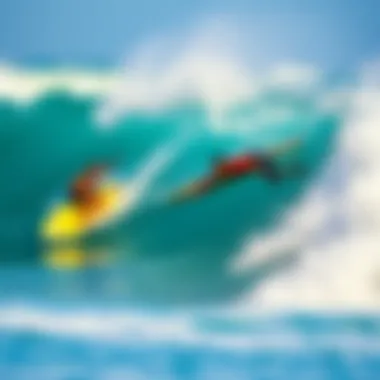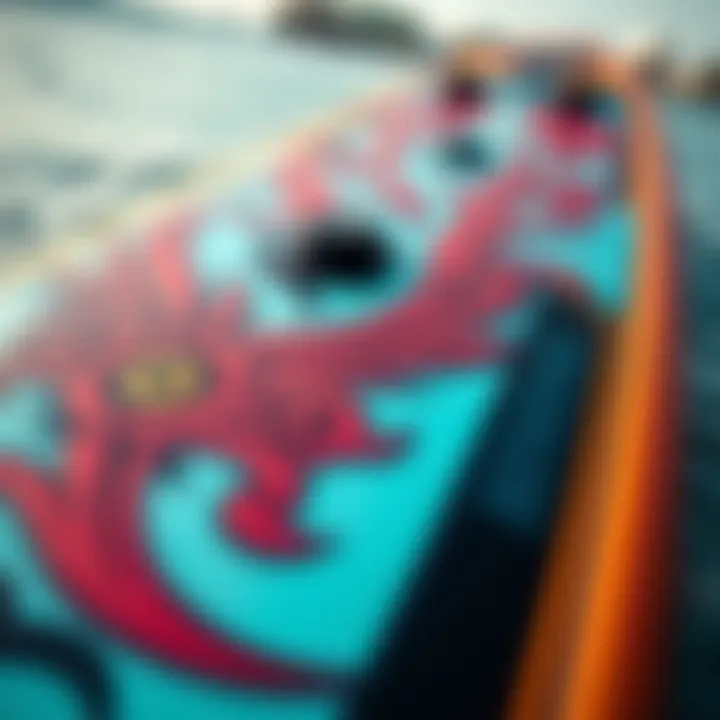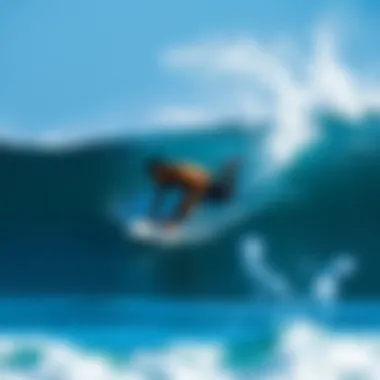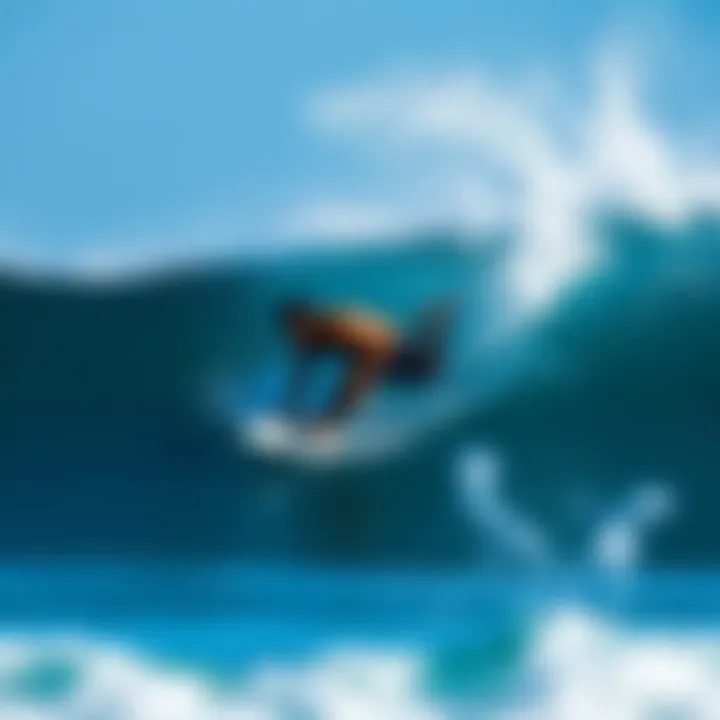Mastering the Waves: Bodyboarding Techniques and Tips


Intro
Catching waves isn’t just a sport, it’s a way of life for many. While surfing atop a board grabs the limelight, bodyboarding holds its own unique charm. Think about gliding across the ocean, riding the swell with only your body and a small board. It’s an intimate experience, a blend of skill and connection to the sea.
Bodyboarding is accessible to a broad spectrum of individuals. It doesn’t carry some of the intimidation or steep learning curve often associated with traditional surfing. Yet, there exists a distinct mastery behind it. This guide aims to unfold the layers of bodyboarding, explore the equipment needed, the techniques to perfect, and the culture that makes it special.
This journey shines a light on
- the evolution of bodyboard technology,
- the vital skills one should have,
- as well as the storytelling that breathes life into this community.
As you read further, you’ll gain insights that could help you refine your abilities as well as deepen your appreciation for the sport. Get ready to immerse yourself in the world of bodyboarding.
Intro to Bodyboarding as a Surfing Discipline
Bodyboarding stands as a unique and dynamic form of wave riding, admired by enthusiasts who appreciate its distinct style and techniques. In this section, we will unpack the significance of bodyboarding within the broader framework of surfing. Understandably, many might view it as a subcategory of surfing itself, yet its essence goes beyond mere categorization; it signifies an entire culture and community steeped in both tradition and modern innovation.
Bodyboarding is not just about sliding down waves; it is about mastering them. One of the key benefits of this discipline is accessibility. Unlike traditional surfing, which may often require a steeper learning curve, bodyboarding offers newcomers a softer landing. You can dive right into the action without needing years of practice to balance on a board. As a result, the sport fosters a welcoming atmosphere for varied skill levels. Whether you’re a child just testing the waters or someone looking to tackle challenging swells, there’s often a spot for you in the lineup.
Moreover, bodyboarding encourages a profound connection with the ocean. Riders spend time observing how waves break, studying their dynamics, and adapting their techniques accordingly. This relationship with the sea cultivates respect for nature. Just as much benefit resides in honing physical skills as it does in fostering an appreciation for environmental awareness. Many riders, through bodyboarding, develop a sense of guardianship toward the ocean and its ecosystems.
As its popularity continues to rise, many young people find inspiration in the sport through video content, competitions, and local surf communities. This brings forth the undeniable fact that bodyboarding is not merely a pastime; it's a lifestyle. Like a family crest passed from one generation to the next, the passion and love for bodyboarding create deep bonds among riders. The camaraderie shared on the waves often transforms into lasting friendships off the board.
In the upcoming sections, we will dive deeper into historical contexts and highlight the key differences between bodyboarding and traditional surfing. It's a journey worth taking, whether you’re a seasoned rider or just curious about this invigorating sport.
“Bodyboarding is more than just a sport; it’s a way to understand and connect deeply with waves.”
Historical Background of Bodyboarding
The roots of bodyboarding trace back to ancient Polynesian cultures who engaged in wave riding on simple wooden planks. These early forms of wave riding were not just recreational; they were integral to cultural rituals and a demonstration of craftsmanship. Over the years, what began as a humble means of enjoying the ocean evolved into a sport recognized globally.
In the 1970s, bodyboarding as we know it today began to take shape. A Hawaiian named Tom Morey is credited with popularizing bodyboarding in modern contexts through the introduction of the first commercially successful bodyboard in 1971. His invention opened doors, allowing more people to connect with the waves uniquely.
From those early days, the sport has increasingly gained traction, especially in places with strong surfing communities. As bodyboarding gained fame, professional events and competitions began to emerge, showcasing top bodyboarders' skills and creativity on the waves.
With each passing decade, bodyboarding matured and diversified. Riders began experimenting with different shapes and materials for boards, which helped the sport evolve into distinct styles. From the classic “dropknee” to prone riding, the variations became a canvas for creativity and individual expression.
Bodyboarding vs. Traditional Surfing: Key Differences
When comparing bodyboarding to traditional surfing, several key differences come to light.
- Positioning: In bodyboarding, riders lie face down on their boards, while surfers often stand upright. This difference impacts not only the style of riding but also how each interacts with the waves.
- Board Design: Bodyboards are generally shorter and more flexible than traditional surfboards, facilitating quicker turns and responsiveness in smaller waves.
- Technique: In bodyboarding, the focus lies on precision and rhythm, often using the body's momentum to gain speed and control in the wave. In contrast, traditional surfing often relies more on balance and strength.
- Accessibility: Bodyboarding can be more accessible to many beginners, as it requires less balance and allows for an easier entry into the surf world.
Understanding Wave Dynamics
Understanding wave dynamics is crucial for anyone looking to master bodyboarding. Waves are not just water moving on the surface; they're a complex blend of energy, swell, and the ocean’s mood. When they break, they can either carry you to glory or toss you around like a rag doll. If you can read and understand these natural phenomena, you can significantly improve your chances of riding the waves like a pro.
Types of Waves and Their Characteristics
Not all waves are created equal. They come in varying shapes and sizes, influenced by factors such as wind direction, coastal geography, and tidal patterns. Here are some key types of waves:


- Beach Break Waves: These waves break over a sandy bottom and are often more forgiving. They can be a great choice for beginners, providing a gentler introduction to bodyboarding.
- Reef Break Waves: These occur over rocky reefs and can be more powerful and sharp. Experienced bodyboarders enjoy the challenges they present, but it's vital to understand the local reef to avoid injuries.
- Point Break Waves: These waves break onto a point of land and can be spectacular for performance. They're known for their long rides and smooth transitions, providing opportunities for tricks and stunts.
Each type of wave carries its own characteristics; some are steep and fast, while others are rolling and slow. A capable bodyboarder identifies these unique features and adjusts their approach accordingly.
Reading the Ocean: Predicting Wave Breaks
To effectively read the ocean, one must develop a keen sense for predicting where and when waves will break. Here are some essential tips for fine-tuning this skill:
- Watch the Swell: Look for the swell direction and its interaction with the shore. Swells that approach at an angle can create better breaks.
- Observe Other Surfers: Keep an eye on your fellow boarders. Experienced surfers can serve as guides; noticing where they position themselves and when they start paddling can provide invaluable clues.
- Wind Conditions: Assess the wind. Offshore winds tend to groom waves, producing clean faces, while onshore winds can make for choppy and messy conditions.
- Tide Influence: Understand how tides affect the breaks. Some spots may work best during high tide, while others shine during low tide.
Essential Gear for Bodyboarding
When it comes to bodyboarding, having the right gear can make a world of difference. Whether you’re just starting out or you’ve been carving waves for years, understanding the essential equipment not only enhances your performance but also keeps you safe in the water. The right setup allows you to catch more waves effectively while also enjoying the ride with comfort and control.
Choosing the Right Bodyboard: Size and Shape
Choosing a bodyboard is akin to selecting a pair of shoes – the fit has to be just right. Bodyboards come in various sizes, typically measured in inches. First, consider your height and weight. As a general rule, your bodyboard should come up to your chest when standing on the ground. If you’re a heavier individual, opting for a wider board can provide better stability.
Also, the shape of the bodyboard affects how it rides the wave. Wider boards are great for beginners, as they offer more surface area and buoyancy. However, for those looking for speed and advanced maneuvers, a narrower board is better suited as it cuts through water more efficiently. The material, often made from polyethylene or epoxy, plays a significant role, too. A stiffer board allows for quicker turns, while a compressible material offers a cushioned experience during those wipeouts.
"A perfectly chosen bodyboard brings the waves closer and makes you feel like you are one with the ocean."
Understanding Fins and Accessories
Fins might seem like a secondary consideration in the grand scheme of your bodyboarding setup, but they are crucial for control and power. Wearing swim fins significantly enhances your ability to paddle out beyond the break and increases your speed as you catch the waves. When selecting fins, look for options with an appropriate size and stiffness that match your paddling strength. Shorter fins tend to be more maneuverable while taller fins give you more thrust.
Other accessories can also add to your bodyboarding experience. A good leash keeps your board tethered to you, preventing it from becoming a runaway hazard when you bail. Wax is critical for grip, as proper traction allows you to stay on the board during intense rides and sharp maneuvers.
The Importance of Rash Guards and Safety Gear
Don’t let the sun or surf get the better of you. Rash guards are a necessary piece of equipment that offer protection against sunburn and rashes caused by board contact. They come in short and long-sleeve variations, with many offering UV protection to keep your skin safe from harmful rays.
Moreover, safety gear is not just for beginners – even seasoned surfers can find themselves in tricky situations. A set of protective pads for elbows and knees can mitigate injuries during falls, while a helmet can protect your noggin from accidental collisions with your board or fellow surfers. In areas with strong currents or rocky breaks, wearing a buoyancy vest might also be prudent as it adds an extra layer of safety if you find yourself in distress.
In summary, investing in proper gear shapes not only your style but ensures your bodyboarding journey remains enjoyable and, most importantly, safe. The ocean can be unpredictable, and having the right tools in your belt sets you up for success.
For more details on bodyboarding gear, check out resources like Britannica or the community discussions on Reddit.
Techniques for Catching Waves
Catching waves while bodyboarding isn’t just a physical activity; it’s an art that requires finesse and understanding of both the ocean and the board itself. Mastering techniques for catching waves is not only essential for enjoyment but is also crucial for safety and efficiency in the water. The right techniques can make the difference between an exhilarating ride and a struggle against the swell, guiding bodyboarders to harness the power of nature rather than resist it.
Understanding Paddle Technique
Paddling isn’t just about moving your arms; it’s the first step in catching a wave. Proper paddle technique sets the stage for a successful ride. Instead of flailing in the water like a fish out of water, a smooth and rhythmic stroke is what you should aim for.
- Body Position: Start by laying over the board with your chest flat to keep the nose down. Your feet should be slightly raised, with your toes touching the tail end of the board. This positioning reduces drag, making it easier to get into the wave.
- Arm Movement: Use long, broad strokes while your hands cut through the water. Think about pulling your arm back like you’re reaching for the wave itself. Make sure your elbows are slightly bent; this will help you maintain speed and power.
- Breathing: Remember to stay relaxed; tense muscles only tire you out faster. Breathe steadily and use your core to maintain balance as you paddle.
When you feel the power of the wave building behind you, your paddling needs to become more vigorous, signaling to the wave that you’re ready to take the ride.


Timing Your Takeoff: The Critical Moment
Timing is a pivotal part of surfing, particularly when it comes to bodyboarding. Being in sync with the wave can be the fine line between success and wipeout. A common mistake is to paddle too early or too late. So how can you nail that perfect moment?
- Watch the Wave: As you bob in the water, keep an eye on how the wave forms. Notice the peak; this is where the wave starts to break. The ideal moment to take off is when the wave is beginning to crest.
- Paddle Harder: As the wave approaches, increase your paddling speed. You need to match the wave’s momentum; if you aren’t fast enough, the wave will simply roll over you.
- Launch Off the Board: When you feel yourself getting lifted, push down on the tail of the board and shift your weight forward. This will allow the board to glide down the wave instead of getting flipped over.
A quick reminder: sometimes you’ll need to accept that a wave is not meant to be. Waiting for the perfect set might save you from a rough tumble.
Positioning and Balance on the Board
Once you are on the wave, the dynamics change again as you need to keep your balance. It’s really about finding that sweet spot where you can maneuver effectively without losing control.
- Weight Distribution: Adapt your weight based on the wave speed and angle. If you feel the board tipping, shift your weight slightly forward if you’re picking up speed or back if you need to stabilize. A well-distributed weight is essential.
- Knees and Elbows: Keeping your knees slightly bent contributes to stability, and don’t forget to engage your elbows. They can act as anchors for your position. Use them effectively to help control your ride.
- Adjusting for Turns: When you want to change direction, lean your body slightly in the desired direction while applying pressure through your toes to pivot. Practice makes perfect; turning may feel tricky at first, but soon it'll become second nature.
By honing your balance, you will not only enhance your riding experience but also enable yourself to experience a greater range of turns and tricks on waves, making you a more versatile and skilled bodyboarder.
Remember: Bodyboarding is as much about flow as it is about technique. Stay calm, listen to the ocean, and with time and patience, you will become one with the waves.
Developing Maneuvering Skills
The ocean can sometimes feel like a fickle friend. To truly master the art of catching waves with a bodyboard, one has to develop a keen sense of maneuvering. Maneuvering skills are essential not only for catching waves effectively, but also for ensuring safety while navigating through challenging surf conditions. Understanding how to guide your board through different types of waves can greatly enhance your surfing experience and keep the rides fun and exhilarating.
Basic Bodyboarding Tricks
Basic tricks form the foundation of any good bodyboarder's skill set. These tricks are critical for building confidence and familiarity with the board. Here are a few essential moves that beginners should practice:
- The Bottom Turn: This maneuver involves turning your board towards the wave as you ride along its face. It helps maintain speed and sets you up for the next move.
- The Snap: By performing a quick turn at the crest of the wave, you can change direction sharply and keep your momentum going.
- The Spin: Once you're comfortable, try completing a 360° spin using your body weight to pivot the board.
- The Drop Knee: This technique requires bending one leg while keeping the other straight, enhancing stability and control as you ride.
These tricks not only make your rides more exciting, but also allow you to adapt to changing wave conditions and improve your overall technique. It’s all about developing muscle memory and getting a feel for what your board can do beneath you.
"Practice is the beginning of mastery."
Advanced Maneuvers for Experienced Riders
Once you've got the basics down, it’s time to dive into more advanced tricks that can give you that edge. These maneuvers require a solid understanding of wave dynamics and quite a bit of practice.
- Air Moves: Techniques like the air reverse involve jumping off the wave and spinning in mid-air, landing back on the board. This takes coordination and timing but is stunning when executed well.
- Rollers: Perform a roll by flipping your body off the board while keeping it in the wave's energy. Practicing this can help improve your aerial skills.
- The El Rollo: This is a combination of an aerial roll and a spin, often used to impress onlookers. The trick lies in timing and the proper execution of body movements.
- The Backflip: As daring as it sounds, it requires precise momentum and grip on your board for success. The satisfaction of landing a backflip is unmatched.
These advanced moves will not only enhance your style but also make you more versatile on the waves. Continuous improvement in these skills keeps the sport engaging and pushes the limits of what you can accomplish on a bodyboard. As you become more adept at maneuvering, remember that safety should never be compromised at the expense of exploration.
Whether you’re at a vibrant beach or negotiating rocky shores, always respect the ocean's power. Regular practice and a grasp of these tricks can uplift your bodyboarding journey to new heights.
Safety Considerations in Bodyboarding
Bodyboarding is an exhilarating sport that allows riders to engage with the ocean like few other activities. However, the thrill comes with its own set of risks. Understanding the safety considerations is paramount for both new and seasoned riders. With proper awareness and preparation, the waves can be not just a playground but a safe environment to hone your skills and enjoy the sea.
Awareness of Hazards: Riptides and Reefs
One of the biggest hazards surfers and bodyboarders face is riptides. These are strong currents that can pull paddlers out to deeper water, posing a serious danger, especially to those who may not be as experienced. Recognizing the signs of riptides can save lives. Look for differences in water color, choppiness, or unusually smooth patches of water. These often indicate the presence of currents pulling away from the shore.


Here are some tips to handle riptides:
- Stay Calm: Panicking only exhausts you. Instead, float and conserve energy.
- Swim Parallel to the Shore: This helps you escape the narrow current. Once free, swim diagonally back to the shore.
- Signal for Help: Raise an arm and wave if you find yourself in trouble; lifeguards are trained to respond quickly.
Reefs also pose unique challenges. Bodyboarding over shallow reefs can lead to cuts, bruises, and even more serious injuries. To mitigate these risks, always check the local surf and tide reports. Visit the beach prior to your session, observing the environment for any potential hazards. Some considerations include:
- Avoiding Low Tide: Shallow waters often expose rocks and reefs, increasing the risk of injury.
- Wearing Protective Gear: A wetsuit not only keeps you warm but protects from abrasions when riding over rough surfaces.
- Respect Local Knowledge: Speak with local surfers about hidden hazards that may not be obvious.
Cultural Impact of Bodyboarding
Bodyboarding is more than just a sport; it represents a way of life for many individuals worldwide. This simple foam board, used to harness the power of the ocean, has emerged as a cultural touchstone, influencing communities far and wide. Through its dynamic nature, bodyboarding fosters connections that transcend geographical boundaries, celebrating shared experiences and collective passion among enthusiasts.
Bodyboarding in Global Surf Communities
The global surf community has embraced bodyboarding with open arms. From the sun-kissed beaches of California to the rugged shores of Australia, bodyboarding has established itself as a central element within surf culture. Each location contributes its unique flavor to the sport, creating a melting pot of styles, techniques, and traditions.
- In Hawaii, for instance, bodyboarding is often viewed with deep respect, intertwined with local customs and legends. Riders don bright board shorts, often adorned with tribal tattoos, as a nod to their cultural heritage.
- In contrast, on the beaches of Portugal, you might find riders seamlessly blending bodyboarding with elements of traditional surfing, demonstrating versatility and fostering camaraderie.
This global interchange not only helps elevate the sport's status but also promotes sustainability. Many bodyboarders champion environmental awareness, organizing beach clean-ups and conservation workshops to maintain the natural beauty of surfers’ beloved playgrounds. As such, engaging in bodyboarding often sparks discussions on environmental stewardship, emphasizing the importance of our oceans not just as a recreational space but as ecosystems in jeopardy.
Influence on Popular Media and Art
Bodyboarding’s visual aesthetic has permeated various forms of media, capturing the attention of photographers, filmmakers, and artists alike. The breathtaking images of riders carving through waves, framed by stunning backdrops, have become iconic representations of this vibrant subculture.
- Documentaries focused on bodyboarding, such as "The Search for the Perfect Wave" and "The Bodyboard Legacy", showcase not just the technical aspects of the sport but also its personal narratives, connecting riders with the audience.
- Art exhibits have even emerged, displaying works inspired by the life of bodyboarders, further solidifying the sport’s place within the cultural landscape.
Moreover, social media platforms serve as fertile ground for bodyboarding culture. Instagram accounts dedicated to the sport feature endless reels of riders catching waves, which not only showcase talent but also create vibrant online communities. Through hashtags like #BodyboardingLife or #WaveRider, enthusiasts connect and share their journeys, extending beyond mere sport into a lifestyle choice that intertwines travel, adventure, and environmental activism.
The essence of bodyboarding lies in its ability to connect people from different walks of life, forming a tapestry rich in stories, backgrounds, and aspirations.
In a world that often feels disconnected, bodyboarding provides a sense of unity, where every wave caught is a shared triumph. With its deep-rooted cultural impact, bodyboarding is poised to continue shaping global surf communities, inspiring the next generation to dive into the foam and ride the waves.
The End: The Future of Bodyboarding
The realm of bodyboarding is undergoing a transformation that intertwines tradition with contemporary innovations. This transition is crucial, not just for the sport itself but also for the community that thrives on the waves. As we look to the horizon, the importance of embracing the future of bodyboarding lies in recognizing the impact technological advancements and cultural shifts have on enthusiasts of all levels.
Emerging Technologies and Innovations
In recent years, technical innovations have sprouted like wildflowers along the beach. These range from improved materials for bodyboards to wearable tech that monitors performance in real-time. Modern bodyboards utilize materials that provide enhanced buoyancy and durability. For instance, EPS foam combined with HDPE slick bottom has made boards lighter and more maneuverable, allowing enthusiasts to ride the waves like never before.
Another fascinating development has been the rise of smart gear. Devices like surf watches or smartphone apps that analyze wave conditions not only help surfers time their takeoff but also provide valuable data for understanding wave patterns and local surf spots. The usage of drones to capture video footage of surfing can provide insight into technique, helping both beginners and pros identify areas for improvement.
This kind of integration between traditional riding and modern technology opens numerous doors for competitive bodyboarding. Competitions now rely on real-time analytics, allowing judges to make more informed decisions, which in turn enhances the viewing experience for spectators as well.
"The blend of creativity and technology is what makes bodyboarding not just a sport, but a continuous evolving art form."
As surf science advances, so too do the techniques and strategies that riders employ. Coaches and advanced training programs can leverage these insights to better prepare their athletes, making them more competitive in larger arenas. The embracing of technology ensures that bodyboarding remains relevant for generations to come.
Encouraging New Generations to Embrace the Sport
In addition to technology, cultivating a passion for bodyboarding among younger generations is critical. Surf schools and community initiatives play a significant role in this endeavor. Programs designed for youth not only teach the mechanics of riding but also impart essential lessons about ocean safety and environmental stewardship.
By offering introduction sessions on beaches or organizing fun competitions, young people can gain hands-on experience while forming a connection with the sport.
Another essential factor is representation in media. As bodyboarding captures moments on social media platforms, increasing visibility helps demystify the art and makes it approachable. Sharing inspirational stories from diverse athletes can motivate newcomers to take up the sport, as seeing someone who looks like them riding the waves can make all the difference.
In the end, the future of bodyboarding hinges on preserving its rich heritage while making innovations accessible to all. Creating an atmosphere where new riders feel welcomed and empowered will ensure the sport not only survives but thrives in the coming years. Opportunities for growth lie not merely in the advancements in the spot but in the hearts of those who choose to dive into its depths.



